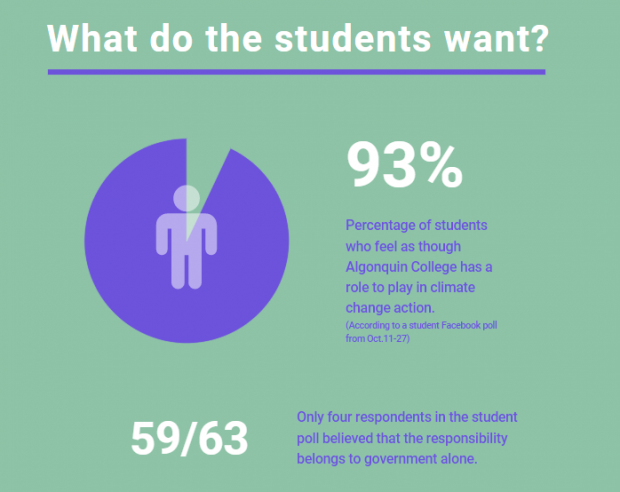Algonquin College’s $9-million sustainable energy venture will start producing results on Oct. 31 when the project’s solar panels and new-energy network will be completely built.
With the increasing number of Canadians coming together and demanding government action on climate change, the college’s administration has been working to create a plan that will reduce greenhouse gas emissions.
In April 2018, the Ontario government sent Algonquin a $9-million grant as part of the Greenhouse Gas Campus Retrofits Program.
John Tattersall, executive director of facilities management, says that the college has invested the funds into three projects that will all be completely built by Oct. 31 of this year.
“The total venture will reduce our GHG emissions by 361.60 metric tonnes per year,” Tattersall said in an email to the Times.
To put these reductions into perspective, it’s useful to use the U.S. Environmental Protection Agency greenhouse gas equivalencies calculator. According to the calculator, an average car driving 4,074 km would produce a single tonne of greenhouse gas emissions.
The three projects that have been underway since the funding was released are the “installation of solar panels; installation of a battery electricity storage capability; and expansion of our thermal network,” according to Tattersall.
Eric Fruhauf, coordinator of the green architecture program at Algonquin, says that there are many areas to focus on when thinking about a sustainable future.
“Production of sustainable energy is certainly a worthy goal as part of a comprehensive sustainable strategy,” Fruhauf said in an email to the Times.
The solar panel and battery electricity storage projects will connect to the campus micro-grid next-year and will produce one megawatt of green electricity for on-campus use.
Typically, a single megawatt can power up to 1000 houses.
Meanwhile, the thermal network project will boost Algonquin’s already existing co-generation plant.
The micro-grid, which is a network of electricity users that flow from a central location but can each operate independently, will be performing at 50 per cent of it’s one megawatt potential until Spring 2020 when the grid will connect to Hydro One’s grid.
Once this Hydro One connection has been completed, the college will be producing the full megawatt as well as the four megawatts of green energy that will flow from the co-generation plant.
Students are largely in favour of Algonquin making efforts to combat climate change.
According to an online poll done by the Times, 59 of the 63 respondents believe that institutions such as Algonquin should play some role in sustainability efforts.
The poll was posted on the Algonquin 2018/19 Facebook group for students over a two-week stretch of time beginning on Oct. 11.
When the funding was announced as part of the province-wide retrofit program in 2018, then-school president Cheryl Jensen outlined the goal of Algonquin becoming carbon-neutral, stating that the school “is making sustainability and the environment a priority”.




